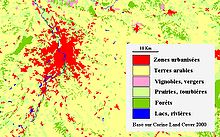
The artificialization of soil, an environment, or natural or semi-natural habitat is the loss of its qualities: its naturalness, a quality that includes a self-sustaining capacity to harbor certain biodiversity, natural cycles (carbon, nitrogen, water, oxygen cycles, etc.), and biogeochemical qualities (carbon sink, for example). It is generally accompanied by a loss of self-healing capacity on the part of the environment (reduced ecological resilience).

Artificialization is often summed up as the disappearance of natural spaces under concrete or bitumen, during the construction of buildings (apartment blocks, hotels, houses, shops, industries, parking lots) or transport networks. While soil sealing is a huge part of land artificialisation, more generally, it takes place when natural environments are heavily transformed by man. For example, leisure and sports facilities (green spaces, golf courses, sports fields, motocross courses, winter sports resorts, etc.), canals, road embankments, and artificial lighting can each lead to ecological traps and other impacts, animal mortality on roads, light pollution, etc., and can also lead to the creation of new habitats. It could also be mentioned the areas developed for military purposes (military testing grounds, underground tunnels, fortifications, glacis, no-man's-land, etc.).

In Europe in 2015, the surface area of sealed land exceeded one million square kilometers, i.e. 2.3% of the European Union's surface area and 200 m² per inhabitant[1] (over 50,000 km2 and 9.4% of the territory in France). On average, 165 ha, or 1,650,000 m² of natural environments and farmland, are destroyed every day in France and replaced by roads, housing, and business parks,[2] as part of the urban sprawl phenomenon. Between 2005 and 2015, this represented almost 6,000 km², the size of a département in ten years.[1] One of the aims of the French Green and Blue Network (TVB or Schéma régional de cohérence écologique) is to limit this phenomenon and mitigate its consequences.[2] Since 2018, the goal of Zero Net Artificialization has been a major roadmap in the fight against artificialization.
- ^ a b Molga, Paul (2018). "Quand la ville ensevelit les sols" [When the city buries the soil]. Les Échos (in French). Retrieved December 25, 2024.
- ^ a b Brethomé, Grégoire (2011). "Trames vertes et bleues : des directives nationales d'ici à la fin de l'année" [Green and blue networks: national guidelines by the end of the year]. actu-environnement.com (in French). Retrieved March 29, 2021.
